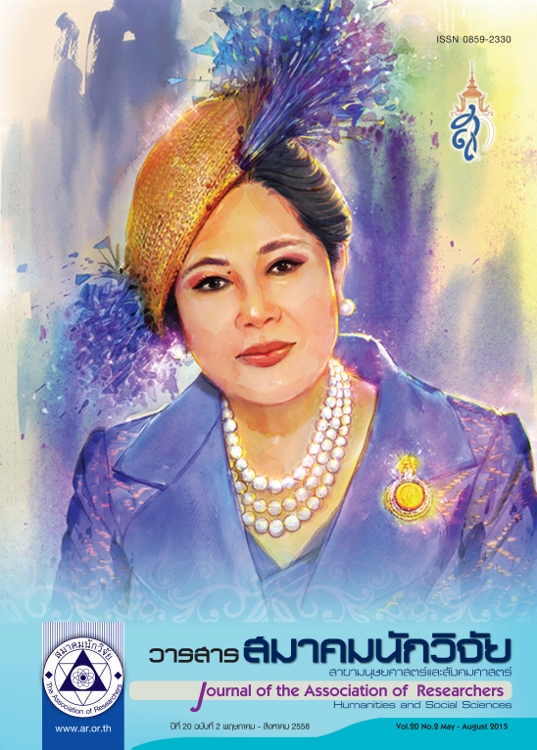Antecedents Affecting on Tourists’ destination loyalty of Phuket Province
Main Article Content
Abstract
The objectives of this research were to study a level of antecedents and tourists’ destination loyalty of Phuket Province and to develop and inspect the harmony of a model of influence paths of causal factors of tourists’ destination loyalty of Phuket Province with empirical data. The samples used in the research were Thai and foreign tourists traveling for sightseeing in Phuket Province, at least 2 times, total 252 tourists by utilizing a two-stage random sampling and conducting data analysis by a path analysis technique. From the data analysis, it is found that the tourists’ destination loyalty of Phuket Province, service quality, value perception, satisfaction and destination image of tourist attraction are in high level. Moreover, from the test hypothesis, it is found that the model of influence paths of causal factors of tourists’ destination loyalty of Phuket Province which are developed by the ersearcher is harmonious with the empirical data, considering from harmony index, namely χ2 = 3.09, df = 1, p-value = 0.07874; GFI = 1.00; AGFI = .97; RMR = .010; RMSEA = .055 by 1) the destination image of tourist attraction affecting value perception, satisfaction and destination loyalty, 2) the value perception affecting satisfaction and destination loyalty, 3) the quality in service affecting satisfaction and destination loyalty and 4). satisfaction affecting destination loyalty.
Article Details
บทความที่ปรากฏในวารสารนี้ เป็นความรับผิดชอบของผู้เขียน ซึ่งสมาคมนักวิจัยไม่จำเป็นต้องเห็นด้วยเสมอไป การนำเสนอผลงานวิจัยและบทความในวารสารนี้ไปเผยแพร่สามารถกระทำได้ โดยระบุแหล่งอ้างอิงจาก "วารสารสมาคมนักวิจัย"
References
มิ่งสรรพ์ ขาวสอาด, สุเมธพฤกษ์ฤดี, จักรีเตจ๊ะวารี, เกษรินทร์ พรหมเป็ง และอาภาภรณ์ สูนพรหม. (2553). รายงาน การสำรวจพฤติกรรมนักท่องเที่ยวชาวต่างชาติ: ตลาดตะวันออก (แผนงานวิจัยการพัฒนาเชิงบูรณาการของการ ท่องเที่ยวที่ยั่งยืนในอนุภูมิภาคลุ่มแม่น้ำโขงปี 2551: ตลาดใหม่และความท้าทาย). เชียงใหม่: สถาบันวิจัย สังคมมหาวิทยาลัยเชียงใหม่.
สุดาดวง เรืองรุจิระ. (2540). หลักการตลาด. กรุงเทพฯ: ประกายพรึก.
Alegre, J., & Juaneda, C. (2006). Destination loyalty-consumer’s economic behavior.
Annals of Tourism Research. 33(3): 648-706. Baloglu, S. (2001). An investigation of loyalty typology and the multi destination loyalty of international tourists. Tourism Analysis. 6: 41-52.
Baker, D., & Crompton, J.(2000). “Quality, Satisfaction and Behavioral Intentions”. Annalsof Tourism Research. 27(3): 785-804.
Backman, S.J.,& Veldkamp. C.(1995). Examination of the relationship between service quality and user loyalty. Journal of Park and Recreation Administration. 13(2): 29-42.
Bojanic, D.C., & Rosen, L.D. (1994). Measuring service quality in restaurants: and application of the SERVQUAL instrument.
Hospitality Research Journal. 18(1): 3-14. Bigne, J.E., Sanchez, M.I., & Sanchez, J. (2001). Tourism image, evaluation variables and after- purchase behavior: Inter-relationship.
Tourism Management. 22(6): 607-616. Castro, C., Armario, E., & Ruiz, D. (2007). “The Influence of Market Heterogeneity on the Relationship Between a Destination’s Image and Tourists’ FutureBehavior. Tourism Management. 28: 175-187. Chaudhuri, A., & Holbrook. M.B. (2001). The chain of effects from brand trust andbrand affect to brand performance: The role of brand loyalty. Journal ofMarketing. 65(2): 81-93.
Chen, C., & Tsai, D. (2007). “How Destination Image and Evaluative Factors AffectBehavioral Intentions?”. Tourism Management. 28: 1115-1122.
Chi, C.,& Qu, H. (2008). Examining the structural relationship of destination image, tourist satisfaction and destination loyalty: an integrated approach. Tourism Management. 29: 624-636.
Chon, K.S. (1990). The role of destination image in tourism: a review and discussion. The Tourist Review. 15: 2-9.
Cronin, J.J., Brady, M.K., &Hult, G.T. (2000). Assessing the effects of quality, value, customer satisfaction on consumer behavioral intentions in service environments. Journal of Retailing: 76(2): 193-218.
Darnell, A., & Johnson, P. (2001). Repeat visits to attractions: a Preliminary economic analysis. Tourism Management. 22 (1): 119-126.
Echtner, C.M., & Ritchie, J.R.B. (1991). The Meaning and Measurement of DestinationImage. The Journal of Tourism Studies. 2(2): 2-12.
Gallarza, M.G., & Saura, I.G. (2006). Value dimensions, perceived value, satisfactionand loyalty: An investigation of university students’ travel.
Tourism Management. 27(2): 437-452. Gronroos, C.(1984). A Service Quality Model and its Marketing Implications European. Journal of Marketing. 18 (4): 36-44.
Gamble, P.R., Stone, M., & Woodcock, N. (1999). Up Close and Personal?. Kogan Page, London. Gotlieb, J.B.,
Grewal, D., & Brown, S.W. (1994). Consumer satisfaction and perceivedquality: complementary or divergent constructs ?. Journal of AppliedPsychology. 79(6): 875-885.
Hsu, C.H., Wolfe, K.,& Kang, S(2004). Image assessment for a destination with limited comparative advantages.Tourism Management. 25, 121-126. Hair, J.,
Anderson, R., Tatham, R., and Black, W. (1998). Multivariate Data Analysis (5 th Edition). Upper Saddle River, NJ: Prentice Hall.
Jenkins, L (1999) Tourist satisfaction with Mallorca, Spain, as an off-season holiday destination. Journal of Travel Research. 38(4): 260-269.
Lee, C.K., Lee, Y.K., & Lee, B.K. (2005). Korea’s destination image formed by the 2002 World Cup. Annals of Tourism Research. 32(4): 839-858.
Lee, C.K., Yoon, Y.S., & Lee, S.K. (2007). Investigating the relationships among perceived value, satisfaction, and recommendations: The case of the Korean DMZ. Tourism Management. 28(1): 204-214.
Marconi, J. (1998). Beyond Branding: How Savvy Marketers Build Brand Equity to Create Proucts and Open New Markets. Chicago, IL: Probus.
Oppermann, M.(2000). Tourism destination loyalty. Journal of Travel Research. 39: 78-84. Oliver, R.L. (1999). Whence consumer loyalty. Journal of Marketing. 63 (specialissue): 33-44.
Petrick, J.F., & Sirakaya,E. (2004). Segmenting cruisers by loyalty. Annals of Tourism Research. 31(2): 472-475.
Shoemaker, S., & Lewis, R.C. (1999). Customer loyalty: the future of hospitality marketing. International Journal of Hospitality Management. 18: 345-370.
Selby, M., & Morgan, N.J. (1996). Reconstruing place image. Tourism Management, 17(4): 287-294.
Tse, D., and Wilton, C. (1988). Models of Consumer Satisfaction: An extension. Journal of Marketing Research. 25(2): 204-212.
Woodruff, R.B.(1997). Customer value: The next source for competitive edge. Journal of the Academy of Marketing Science. 25(2): 139-153.
Yoon,Y., & Uysal, M. (2005). An examination of the effects of motivation and satisfaction on destination loyalty: a structural model. Tourism Management. 26(1): 45-56.


